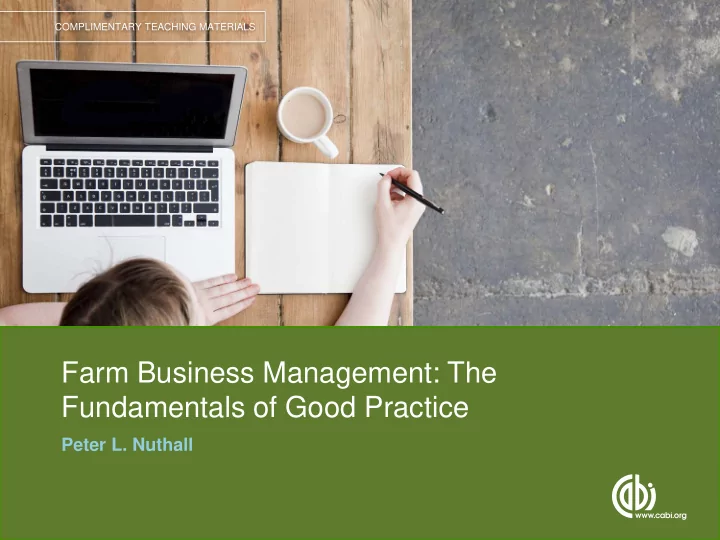

COMPLIMENTARY TEACHING MATERIALS Farm Business Management: The Fundamentals of Good Practice Peter L. Nuthall
Chapter 14 Improving Farming Systems Using Survey Data COMPLIMENTARY TEACHING MATERIALS
LEARNING OBJECTIVES Understand the concept of both quantitative and qualitative farm surveys. Discover the farm system improvement ideas in ‘comparative analysis’ and farm standards, or benchmarks. Learn about the procedures used in working with comparative analysis. Question the use of comparative analysis through learning about its disadvantages and advantages. Comprehend the concept of a whole farm production function and its possible use in improving a farming system. Similarly, discover the ideas involved in ‘cost accounting’. Learn about measuring farm system efficiency, residual imputation and resource valuation and their implications in ranking farms. COMPLIMENTARY TEACHING MATERIALS
Farm Surveys - Purposes Every farm can be regarded as an experiment: use them to resolve issues and questions. Farm survey: collect data from farms to assess topic of interest. Potential questions and topics: anything about farms, e.g.: • profit levels environmental pollution • • debt levels • efficiency level and its improvement. Limits: data must be able to be collected reasonably accurately. COMPLIMENTARY TEACHING MATERIALS
Farm Surveys - Procedures Choice of quantitative or qualitative, or mixed method. Quantitative: facts and figures are collected and analysed; Qualitative: thoughts and feeling of farmers are gathered. Use a sample: • less expensive to gather from less than the whole population; • provided there are similarities between farms, a sample can be just as accurate. • Selection method for sample is important to give accuracy. Data is historic: Surveys deal with the past. Must ask will the future be the same? Collection methods: personal interviews, existing records (farm accounts?), postal, telephone. Use question schedule to guide collection. COMPLIMENTARY TEACHING MATERIALS
Comparative Analysis (Benchmarking): The Basics Rank farms and obtain statistics describing characteristics. Compare best with individual farm being analysed. Use comparisons to diagnose problems. Then continue with comparisons to suggest improvements. Information for the farm comparative statistics collected through surveys and/or farm accounts/records. Computers mean there is little limit to the number of statistics and ratios that can be calculated. COMPLIMENTARY TEACHING MATERIALS
Comparative Analysis: The Method Calculate summary statistics for each farm: physical and financial, animal, cropping, costs, returns, per hectare, per animal. Divide farms into efficiency groups; get average statistics for each group. Compare statistics of farm under study with the averages of the best farms group. Analyse: compare net income and other summary statistics. How bad is the farm? What is wrong: product mix; input levels; labour levels? COMPLIMENTARY TEACHING MATERIALS
Critique of Comparative Analysis (Benchmarking): General Difficult to get homogenous conditions to allow comparison of farms. Compare like with like. Data is historical: the future is the important thing. ‘Best’ farms are unlikely to really be the ‘top’ possible with perfection. Comparisons use averages, yet decisions should be based on marginal figures. Averages may not be statistically different; need a statistical tests (e.g. t tests). Farmers decide on inputs, not outputs. Thus grouping should be on inputs. COMPLIMENTARY TEACHING MATERIALS
Critique of Comparative Analysis (Benchmarking): Specifics Technologist’s dilemma: which physical measures are correct, e.g. production per ha or per animal? Fallacy of money and physical factor/factor ratios, e.g. $output/$labour input lead to non-optimal least cost combinations. Yearly variations in best farms and benchmarks (standards): which is correct? Use conglomerates of outputs: individual activities not isolated. Limited scope of comparisons, e.g. not ownership structures, tax policy, finances. Data comparability dubious, e.g. managers’ skills not identical, farms in different states of life cycle. COMPLIMENTARY TEACHING MATERIALS
Benefits of Comparative Analysis and a Conclusion Ease: anyone can carry out an analysis with little training or knowledge. Interest: the comparison creates enormous interest from farmers; stimulus. Cost of operation: relatively inexpensive. Conclusion : provides a starting point for analysis that farmers enjoy. However, final decisions must be based on production functions and production economics using future expectations. COMPLIMENTARY TEACHING MATERIALS
Other Methods of Using Survey Information Whole farm production functions developed from data. Select a function and use regression analysis to calculate parameters. However, the detail is usually insufficient to give management advice. Cost accounting: • Separate out income and all costs for each product to see the best. • While can allocate variable costs to each activity (product), fixed (overhead) costs have no logical allocation basis, so estimated profits per product are misleading and arbitrary. Results can be helpful to governments if setting prices. COMPLIMENTARY TEACHING MATERIALS
Measuring Efficiency For comparisons need a measure of ‘efficiency’. Several choices, e.g.: • return on capital (profit/total farm capital as a %); • return to ‘labour and management’ of owner/manager (income less all expenses other than manager); profit surplus (net profit after deducting estimated costs of all ‘free’ • inputs (e.g. manager, capital)). Which one? Depends on farmer’s objectives. Is it a ratio? Is it a surplus? A problem is each can rank which farm is best differently! Profit surplus likely to be best because farmers want absolute surplus, but for comparisons must convert to, say, surplus per hectare. Also, the non-paid factors might be charged incorrectly: are their values correct? COMPLIMENTARY TEACHING MATERIALS
Residual Imputation and Resource Valuation Efficiency measures are largely residual: the leftover is allocated to the residual input (e.g. return on capital). When costing the other non-paid factors, a charge is worked out some way or another. This may not be the non-paid factors’ true value. True value comes from the resources’ marginal value product. Thus, if the true value is not used for non-paid factors, the residual will include returns to other resources and be incorrect as a true value. COMPLIMENTARY TEACHING MATERIALS
Thank You Name: First Surname Email: email@email.com COMPLIMENTARY TEACHING MATERIALS
Recommend
More recommend